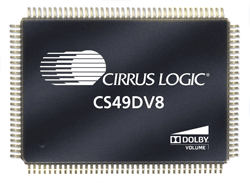The Ultimate Resource for Building Next-Generation Systems
SemiApps allows electronic design engineers to easily and quickly find product vendors who provide chipsets, application-focused ICs, customizable or programmable platforms and specialized components for particular applications. New and interesting blogs from industry experts are also featured on the site (www.semiapps.com).
Readers Choice: The best new application-specific ICs
Among the most popular products on the site this past month is Samsung’s new 256-Gbyte solid-state drive (SSD). The unit more than doubles the performance rates of the company’s 64- and 128-Gbyte SSDs combining sequential read rates of 220 Mbytes/s with sequential write rates of 200 Mbytes/s. This sharply narrows the performance gap between read and write operations to only 10%, compared to a read-write speed difference of between 20% and 70% for other SSDs.
In addition, erase cycles are a rapid 100 Gbytes/min, allowing the entire drive to be rewritten much faster, when needed. According to Samsung, The 256-Gbyte SSD in a notebook is analogous to having a 15,000-rpm drive, without all of its size, noise, power, and heating drawbacks.
The 2560Gbyte SSD expedites data transfer when large multimedia files are simultaneously read and stored. It can store 25 high-definition movies in just 21 minutes, a significant advancement over a 7,200-rpm HDD, which takes about 70 minutes. Furthermore, the 256-Gbyte SSD launches applications 10 times faster than the fastest 7,200-rpm notebook HDD.

Cirrus Logic’s CS49DV8 audio DSP
Cirrus Logic’s multichannel surround sound audio DSP with Dolby volume technology has also attracted huge interest at the site. Targeting a wide variety of consumer home theater applications, the CS49DV8 eight-channel, dual-core, 32-bit audio DSP allows consumers to set the audio volume at their preferred listening level — and have it stay that way.
Targeting multichannel surround sound applications such as audio/video receivers, home theater-in-a-box applications, and speaker bars, the audio DSP also offers audio post processing capabilities, such as bass management, parametric equalization, bass and tone control, multizone generation, and a multitude of additional third-party post-processing algorithms from companies such as Dolby, THX, SRS Labs, and DTS.
For the second month in a row, NXP’s flat-screen TV “platform” received huge number of clicks from visitors to Semiapps.com. The NXP TV550 single chip TV platform enables switching from analog to digital, from SD to HD and from broadcast to networked TV.
The NXP TV550 features the company’s PNX85500 processor and integrates Motion Accurate Picture Processing technology. It combines NXP‘s digital TV processing and picture-quality technology into one fully integrated single chip. The TV550 also enables a production-ready reference design that speeds manufacturers‘ development and dramatically reduces the bill of materials.
Engineering blogs of the month
In a very popular blog this month, Peter Helfet the chief executive officer of EqcoLogic NV, argues in favor of using coaxial cabling for in-vehicle networks, including entertainment and navigation systems, claiming that coax offers the highest data rates at the lowest cost. Helfet believes the 1394 Copper Automotive Standard is the blueprint for next generation networking in cars offering net data rates of up to 800 Mbits/s (1394 “S800” speed), from the start. “This compares extremely favorably with 25-Mbit/s offered by MOST optical networks today and even the future 150-Mbit/s MOST specification.”

Peter Helfet of EqcoLogic NV
The 1394 Copper Automotive Standard also allows for networks built on a number of cable/connector systems, including “shielded twisted quad” (STQ), “shielded twisted pair” (STP) and single coaxial operating in full-duplex mode. Using low-cost automotive coaxial cables, like the RG174 with FAKRA coaxial connectors, the transceiver allows a cable range at S800 speeds of up to 20 m with the network operating at S800 even with a number of in-line connectors. This is effectively double the range achieved with current STQ or STP cable systems. In addition, coaxial cabling and connectors are very low cost so that, even taking into account the addition of the transceiver circuits, total link cost can be as low as 50% of the cost with more complex cabling.
In another very popular blog, Robert A. Burckle, vice president of WinSystems, delves into the issue of legacy products. “How many times have you heard a electronics company proudly proclaim that they are ‘legacy-free’ with their new product or architecture? In some cases this is a necessity that will improve price/performance and/or reduce its impact on the environment, while at other times it is devastating for a customer who continues to need product for a long period of time,” says Burckle in his blog: “Legacy Support: Lifeline or Boat Anchor?”
He says an existing product can be made prematurely obsolete simply because legacy-free is more elegant is not a good business solution for the manufacturer or the customer. Depending upon each customer’s application, market, and level of integration, legacy support can be a lifeline or boat anchor. For more on Burckle’s blog, check out the SemiApps.com site.
Design Classics Library: Application notes of note and more
At the recent Consumer Electronics Show (CES 2009), Cavium Networks and Ralink unveiled a joint reference design for seamless wireless high-definition video distribution in the home using industry standard IEEE 802.11n and MPEG H.264 technology.

The Cavium PureVu video processor CNW3602
The reference design uses the Cavium PureVu CNW3602 video processor, recently acquired from W&W Communications and the Ralink 802.11n MIMO Wireless RT2880 chipset. The PureVu Video Processor compresses 1080p quality video to sub 50 Mbits, which can now be sent with high reliability over a standard Wi-Fi network. This is achieved with perceptual lossless quality and subframe latency using the patented Super Low Latency (SLL Technology) technology. The Ralink 802.11n chipset uses MIMObility Technology to support up to 300 Mbits/s with robust connections at extended range.
The reference design provides electronic manufacturers with low, consumer friendly price-point BOM cost while supporting up to full 1080p60 high-definition video streaming with the subframe latency required for high-definition wireless gaming applications. The reference design supports up to 7.1 surround sound digital audio, HDMI version 1.3a compliant, with support for Consumer Electronics Control (CEC) functionality and legacy IR blaster control.
Marty Gold
Find out more on what visitors to SemiApps.com looked at most at www.SemiApps.com/thismonth.
Advertisement
Learn more about Electronic Products Magazine





